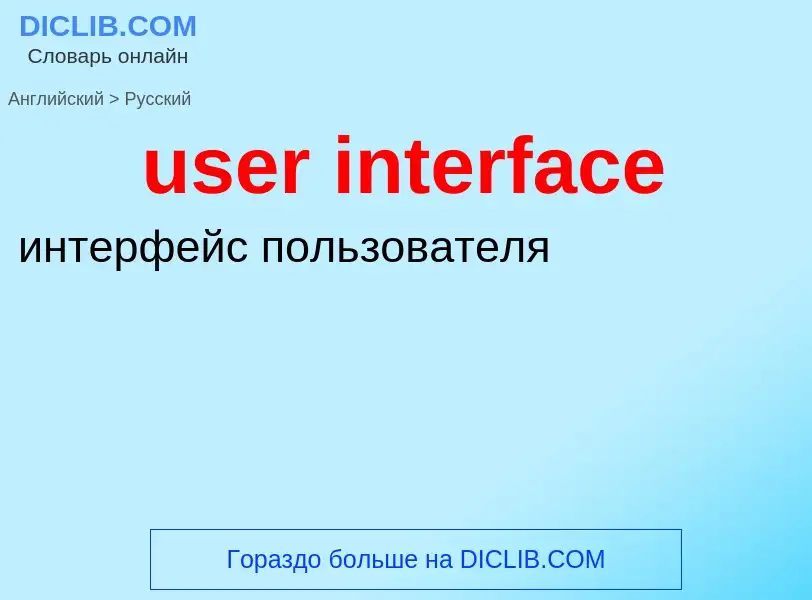Translation and analysis of words by ChatGPT artificial intelligence
On this page you can get a detailed analysis of a word or phrase, produced by the best artificial intelligence technology to date:
- how the word is used
- frequency of use
- it is used more often in oral or written speech
- word translation options
- usage examples (several phrases with translation)
- etymology
user interface - translation to russian
общая лексика
пользовательский интерфейс
определяет способ взаимодействия пользователя с компьютерной системой. Может быть текстовым, графическим, речевым
Смотрите также
Wikipedia

In the industrial design field of human–computer interaction, a user interface (UI) is the space where interactions between humans and machines occur. The goal of this interaction is to allow effective operation and control of the machine from the human end, while the machine simultaneously feeds back information that aids the operators' decision-making process. Examples of this broad concept of user interfaces include the interactive aspects of computer operating systems, hand tools, heavy machinery operator controls and process controls. The design considerations applicable when creating user interfaces are related to, or involve such disciplines as, ergonomics and psychology.
Generally, the goal of user interface design is to produce a user interface that makes it easy, efficient, and enjoyable (user-friendly) to operate a machine in the way which produces the desired result (i.e. maximum usability). This generally means that the operator needs to provide minimal input to achieve the desired output, and also that the machine minimizes undesired outputs to the user.
User interfaces are composed of one or more layers, including a human-machine interface (HMI) that interfaces machines with physical input hardware such as keyboards, mice, or game pads, and output hardware such as computer monitors, speakers, and printers. A device that implements an HMI is called a human interface device (HID). Other terms for human–machine interfaces are man–machine interface (MMI) and, when the machine in question is a computer, human–computer interface. Additional UI layers may interact with one or more human senses, including: tactile UI (touch), visual UI (sight), auditory UI (sound), olfactory UI (smell), equilibria UI (balance), and gustatory UI (taste).
Composite user interfaces (CUIs) are UIs that interact with two or more senses. The most common CUI is a graphical user interface (GUI), which is composed of a tactile UI and a visual UI capable of displaying graphics. When sound is added to a GUI, it becomes a multimedia user interface (MUI). There are three broad categories of CUI: standard, virtual and augmented. Standard CUI use standard human interface devices like keyboards, mice, and computer monitors. When the CUI blocks out the real world to create a virtual reality, the CUI is virtual and uses a virtual reality interface. When the CUI does not block out the real world and creates augmented reality, the CUI is augmented and uses an augmented reality interface. When a UI interacts with all human senses, it is called a qualia interface, named after the theory of qualia. CUI may also be classified by how many senses they interact with as either an X-sense virtual reality interface or X-sense augmented reality interface, where X is the number of senses interfaced with. For example, a Smell-O-Vision is a 3-sense (3S) Standard CUI with visual display, sound and smells; when virtual reality interfaces interface with smells and touch it is said to be a 4-sense (4S) virtual reality interface; and when augmented reality interfaces interface with smells and touch it is said to be a 4-sense (4S) augmented reality interface.



![WIMP]] GUI WIMP]] GUI](https://commons.wikimedia.org/wiki/Special:FilePath/AMX desk box.jpg?width=200)

![Holes are punched in the card according to a prearranged code transferring the facts from the census questionnaire into [[statistics]]. Holes are punched in the card according to a prearranged code transferring the facts from the census questionnaire into [[statistics]].](https://commons.wikimedia.org/wiki/Special:FilePath/Card puncher - NARA - 513295.jpg?width=200)




![A [[graphical user interface]] following the [[desktop metaphor]] A [[graphical user interface]] following the [[desktop metaphor]]](https://commons.wikimedia.org/wiki/Special:FilePath/XFCE-4.10-Desktop.png?width=200)
![German]] [[steam locomotive]] German]] [[steam locomotive]]](https://commons.wikimedia.org/wiki/Special:FilePath/P8-führerstand2.jpg?width=200)
![German]] [[Intercity-Express]] high-speed train German]] [[Intercity-Express]] high-speed train](https://commons.wikimedia.org/wiki/Special:FilePath/Ice3 leitstand.jpg?width=200)

![[[Voice user interface]] of a [[wearable computer]] (''here: [[Google Glass]]'') [[Voice user interface]] of a [[wearable computer]] (''here: [[Google Glass]]'')](https://commons.wikimedia.org/wiki/Special:FilePath/Google Glass detail.jpg?width=200)

![HMI for a [[computer numerical control]] (CNC) HMI for a [[computer numerical control]] (CNC)](https://commons.wikimedia.org/wiki/Special:FilePath/CNC panel Sinumerik.jpg?width=200)



